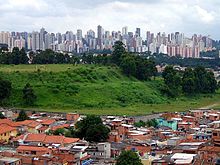Wealth inequality in Latin America
This article needs to be updated. (November 2019) |

Wealth inequality in Latin America and the Caribbean refers to economic discrepancies among people of the region. A report release in 2013 by the UN Department of Economic and Social Affairs entitled Inequality Matters. Report of the World Social Situation, observed that: ‘Declines in the wage share have been attributed to the impact of labour-saving technological change and to a general weakening of labour market regulations and institutions.[1] Such declines are likely to affect individuals in the middle and bottom of the income distribution disproportionately, since they rely mostly on labour income.’ In addition, the report noted that ‘highly-unequal land distribution has created social and political tensions and is a source of economic inefficiency, as small landholders frequently lack access to credit and other resources to increase productivity, while big owners may not have had enough incentive to do so.[1][2]
According to the
In 2008, According to UNICEF, Latin America and the Caribbean region had the highest combined
According to a study by the

According to the
.Many countries in Latin America have responded to high levels of poverty by implementing new, or altering old,
Sources
![]() This article incorporates text from a free content work. Licensed under CC-BY-SA IGO 3.0 (license statement/permission). Text taken from Rethinking Education: Towards a global common good?, 24, UNESCO. UNESCO.
This article incorporates text from a free content work. Licensed under CC-BY-SA IGO 3.0 (license statement/permission). Text taken from Rethinking Education: Towards a global common good?, 24, UNESCO. UNESCO.
References
- ^ ISBN 978-92-3-100088-1.
- ISBN 978-92-1-130322-3.
- )
- David de Ferranti et al. An example of the policies introduced to combat the poverty and inequality was the import substitution industrializationeconomic policy. This policy sought to grow national industry and offer protection from foreign competition as a means to reduce external dependencies and improve local economies. "Inequality in Latin America:Breaking with History?", The World Bank, Washington, D.C., 2004
- PMID 9596604.
- ^ Tacon, P. (1982). "Carlinhos: the hard gloss of city polish". UNICEF news.
{{cite journal}}: Cite journal requires|journal=(help) - ISBN 978-1-4129-2694-2.)
For example, in many parts of Latin America, racial groupings are based less on the biological physical features and more on an intersection between physical features and social features such as economic class, dress, education, and context. Thus, a more fluid treatment allows for the construction of race as an achieved status rather than an ascribed status as is the case in the United States.
{{cite book}}:|author=has generic name (help - ^ Nutini, Hugo; Barry Isaac (2009). Social Stratification in central Mexico 1500–2000. University of Texas Press. p. 55.
There are basically four operational categories that may be termed ethnic or even racial in Mexico today: (1) güero or blanco (white), denoting European and Near East extraction; (2) criollo (creole), meaning light mestizo in this context but actually of varying complexion; (3) mestizo, an imprecise category that includes many phenotypic variations; and (4) indio, also an imprecise category. These are nominal categories, and neither güero/blanco nor criollo is a widely used term (see Nutini 1997: 230). Nevertheless, there is a popular consensus in Mexico today that these four categories represent major sectors of the nation and that they can be arranged into a rough hierarchy: whites and creoles at the top, a vast population of mestizos in the middle, and Indians (perceived as both a racial and an ethnic component) at the bottom. This popular hierarchy does not constitute a stratificational system or even a set of social classes, however, because its categories are neither exhaustive nor mutually exclusive. While very light skin is indeed characteristic of the country's elite, there is no "white" (güero) class. Rather, the superordinate stratum is divided into four real classes—aristocracy, plutocracy, political class, and the crème of the upper-middle class—or, for some purposes, into ruling, political, and prestige classes (see Chap. 4). Nor is there a mestizo class, as phenotypical mestizos are found in all classes, though only rarely among the aristocracy and very frequently in the middle and lower classes. Finally, the bottom rungs are not constituted mainly of Indians, except in some localized areas, such as the Sierra Norte de Puebla
- ISBN 978-0-205-78618-3
- ISBN 0-520-04280-8.
[I]n the New World all Spaniards, no matter how poor, claimed hidalgo status. This unprecedented expansion of the privileged segment of society could be tolerated by the Crown because in Mexico the indigenous population assumed the burden of personal tribute.
- ISBN 0-8047-0912-2.
- ^ See Passing (racial identity) for a discussion of a related phenomenon, although in a later and very different cultural and legal context.
- ISBN 0-8047-2159-9.
- ^ a b Francisco H. Ferreira et al. Inequality in Latin America: Breaking with History?, The World Bank, Washington, D.C., 2004
- ^ Nicola Jones; Hayley Baker. "Untangling links between trade, poverty and gender". ODI Briefing Papers 38, March 2008. Overseas Development Institute (ODI).
- ^ Isabel Ortiz; Matthew Cummins (April 2011). "Global Inequality: Beyond the Bottom Billion" (PDF). UNICEF. p. 26.
- .
- ^ "- Human Development Reports" (PDF). undp.org.
- ^ "World Development Indicators database, 1 July 2011". Gross national income per capita 2010, Atlas method and PPP. World Bank Organization (WBO).
- ^ Barrientos, A. and Claudio Santibanez. (2009). "New Forms of Social Assistance and the Evolution of Social Protection in Latin America". Journal of Latin American Studies. Cambridge University Press 41, 1–26.
- ^ Benedicte de la Brière and Laura B. Rawlings, "Examining Conditional Cash Transfer Programs: A Role for Increased Social Inclusion?", Social Safety Net Primary Papers, The World Bank, 2006, p.4
- ^ "Regional Human Development Report for Latin America and the Caribbean 2010" (PDF). Inequality in Latin America and the Caribbean.
- ^ "Societies on the move". The Economist. 2010-09-11.
- ^ Monika Huber; Wolfgang Kaiser (February 2013). "Mixed Feelings". dandc.eu.
